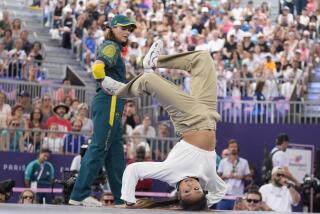For Olympians, faster, higher, stronger -- no longer?
- Share via
One of the big stories of the London Olympics was that the swimming performances didn’t do a collective belly flop after the 2010 ban on high-tech, full-body swimsuits. Eight swimming world records were bested in the Olympic pool. That’s nowhere near the 25 swimming records surpassed four years ago in Beijing (or the 43 demolished in the 2009 World Championships). Still, it’s impressive given the predictions that swim times might not rebound for a decade.
In addition to the swimming records, there were three new world records in the track competitions, four in cycling and six in weightlifting — a testament to human potential and to the Olympic creed that we can always go faster, higher, stronger.
But can we? Both the data (and logic) suggest that there are limits to human athleticism and that we’re fast approaching them. The looming question: How will elite athletes (and the rest of us) respond when contests are no longer about being the best ever in a sport but rather about being the best in a round of competition?
PHOTOS: U.S. brings home the gold
Plot the world-record progression in swimming and track events over the last several decades and two things stand out: that human athleticism is relentlessly progressing and that the slope of improvement has been flattening in many events. For example, on July 29, Cameron van der Burgh of South Africa swam a world-record 100-meter breaststroke in 58.46. That’s 2.83 seconds faster than the world’s best 20 years ago. But over the previous 20 years (between 1972 and 1992) swimmers lopped 4.39 seconds off the record. Then there’s Florence Griffith-Joyner’s 1988 world record of 10.49 in the women’s 100-meter sprint, which has stood for nearly a quarter-century.
Researchers who have crunched the numbers on more than a century of world-record and top-10 times across a wide range of sports argue that performances in a significant portion of swimming and track competitions are, or soon will be, stagnant. In a 2008 study, appropriately titled “The Citius End,” Geoffroy Berthelot, a researcher at Paris’ Institute for Biomedical Research and Sports Epidemiology, wrote that the statistical model he and his colleagues developed “forecasts that human species’ physiological frontiers will be reached in one generation.”
Then what? Defying limits has done us a lot of good, and so one idea is that we will find little ways to keep the records falling. For instance, though London’s swimmers were deprived of extra-speedy suits, they were the first Olympians to have the advantage of inclined starting blocks. Indeed, many of the Olympic facilities in London were engineered for extra speed, including a water circulation system that minimized turbulence in the pool and a springier track surface.
PHOTOS: London Olympics | Track and field
Or, take Van der Burgh’s post-race admission that he used illegal dolphin kicks during his record-setting swim. His excuse? Everybody does it. “If you’re not doing it,” he told a reporter for the Sydney Morning Herald, “you’re falling behind.” And the International Olympic Committee seems inclined to agree, having made no moves to strip Van der Burgh of his medal or scrub his record.
Similar sentiments have been heard from world-class runners and cyclists caught doping. That kind of rule-bending still has serious consequences, at least for now, but many people argue that anti-doping efforts are beset by double standards and that it’s going to be extremely difficult to keep chemical and other scientific enhancements out of sports. An article in last month’s edition of the journal Nature mused about the many ways science could help athletes topple human limits, including gene therapy, bionic limbs and better, safer drugs. The article quoted Scottish bioethicist Andy Miah, who suggested a “World Pro-Doping Agency” to “invest in safer forms of enhancement.”
Another idea is to time races to the thousandth of a second. It won’t make people swim or run any faster, but it could keep the record-breaking going a while longer. In the rarefied atmosphere of athletic world records, time is elastic. The number of seconds (or thousandths of a second) is much less important than the meaning we invest in them. That meaning is simply this: We can do better.
That was the message nearly 60 years ago when England hosted one of history’s most remarkable record-breaking runs. On a damp May day at Oxford in 1954, Roger Bannister ran a mile in under 4 minutes. He beat a record that had stood for nine years. But he wasn’t just faster; he broke through a barrier and busted myths of impossibility. That’s why Bannister is remembered and John Landy, who beat his record less than two months later, isn’t.
Then again, maybe it won’t matter when the records stop falling. After all, the sprint events at the track are among the Olympics’ marquee competitions, scheduled for prime-time television viewing and watched by millions, even though world records have slowed to a trickle. The three world records set in London are about par for the last two decades of Olympics. These are still races pitting the fastest humans alive against one another, and watching that kind of determination provides awesome human drama, sparked by intense rivalries, international bragging rights and champions defending their crowns. These athletes compete fiercely. They run in the shadow of past Olympic disasters and prevail. They finish races even after tearing an Achilles tendon or breaking a leg.
Thanks in large part to the amazing feats of Jamaican sprinter Usain Bolt, world records in the track’s sprint events still seem vulnerable. The possibility that we will witness the best ever still crackles over many elite, international finals.
One day, perhaps sooner than we think, it may not. Will we still tune in to watch? I will.
Chris Berdik is a science journalist and the author of the forthcoming book “Mind Over Mind: The Surprising Power of Expectations.”
More to Read
A cure for the common opinion
Get thought-provoking perspectives with our weekly newsletter.
You may occasionally receive promotional content from the Los Angeles Times.










